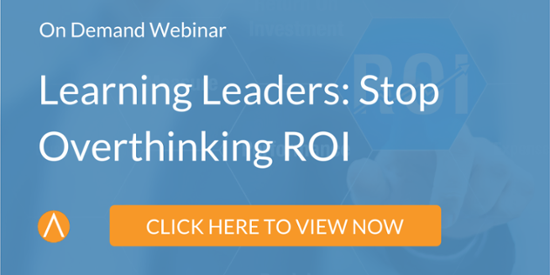Posted by Caveo Learning ● June 23, 2016
4 Fundamentals of Effective Learning Metrics & Measurement
A learning and development organization that lacks effective metrics and measurement is going to have a difficult time proving its business value to the enterprise. Having comprehensive learning metrics in place is a key reason that successful learning leaders have the respect of business leaders and are able to get their talent development initiatives funded.
When taking the first steps toward implementing a measurement process, try not to overthink it. While collecting effective metrics and determining the ROI of learning takes planning and strategizing, it doesn't have to be a terribly complex process.
There are four key areas to focus on in the measurement journey, and they all tie back to business results. By measuring intent, knowledge, performance, and impact, learning leaders achieve insight into how to improve learning solutions—and just as importantly, they'll be able to prove that value to the business.
Start by Identifying Business Goals
All organizations, even nonprofits, have business goals. They may include financial, operational, environmental, technical, or any combination. These goals drive performance expectations, and the L&D function is responsible for helping to meet performance expectations, so, it follows that learning objectives must be aligned.
L&D team members must be able to articulate the organization’s business goals. It’s helpful when L&D team members understand the industry, their organizational structure, and the roles and responsibilities of other business units.
In the initial stages of design, learning professionals should ask questions that focus on performance and behavior:
- “What do you expect the team member to be able to do?”
- “What are they doing now that you don’t want them to do?”
- “How does this new (policy, procedure, software) impact the job?”
- “What is the ideal behavior you hope to see?”
The answers to these questions drive learning objectives, measurement, and alignment with business goals.
4 Areas of Measurement Focus
 Intent
Intent
The intent of the learner to apply knowledge and skills has a great deal of impact on the effectiveness of learning, especially with regard to performance and behavior. Surveys that measure intent to apply knowledge and skills can also be useful in identifying barriers back on the job.
Intent and reaction-based surveys are usually one of the final activities during the learning process and usually include questions about the experience itself and intent to apply back on the job. Do still ask questions about materials and instructors to identify areas to improve. Consider weighing questions more toward intent to apply, how the learner plans to apply, and perceived barriers.
Knowledge
People need a base of knowledge to perform, regardless of tasks or previous experience. Consider measuring knowledge gain when the learning includes new terminology, principles, processes, structures, and prerequisite information to perform a task.
Traditional quiz questions, mini-scenarios, and short case studies all work well to measure knowledge acquisition. Ensure that the knowledge check items are aligned to learning content. Avoid “all of the above” and “none of the above” answer options; if you want to make the point that there are a variety of options, use a multiple-select question type and provide feedback that explains why all or none apply. Finally, design questions and responses to avoid tipping off the correct answer.
Performance/Behavior
Most learning focuses on changing or improving performance or behavior. It’s important to measure performance improvement and behavior changes at several points.
During the learning process, case studies, scenarios, role play, and other practice or assessment can serve to validate that the learner is ready to perform or can display expected behavior. Some organizations formalize this type of assessment as certification or a prerequisite to move forward.
While it’s valuable to measure performance improvement and behavior change during and shortly after learning, measuring long-term impact is key to determining whether learning was effective and if obstacles remain. Consider sending surveys to learners and their managers several months after learning has concluded. Pre- and post-learning performance statistics can also be compared, especially if learning objectives included specific numbers or percentages. This type of measurement overlaps with the impact level of measurement.
Impact/ROI
A sound measurement strategy demonstrates how learning has impacted business results. Careful planning and baselining are key to correlating “before” and “after” business results with learning. Reduced cost, improved quality and efficiency, increased productivity, employee retention, and increased sales are common business results that align with learning. In addition to comparing data before and after learning, one must calculate return on investment (ROI), which is to compare the total cost of learning with the impact on business results.
Topics: Metrics & Measurement, Learning Strategy

